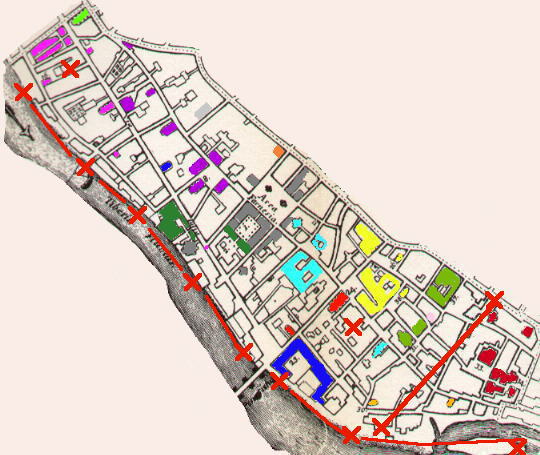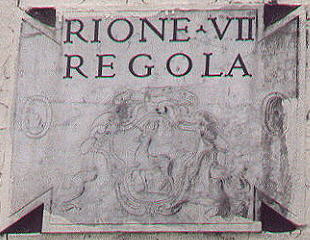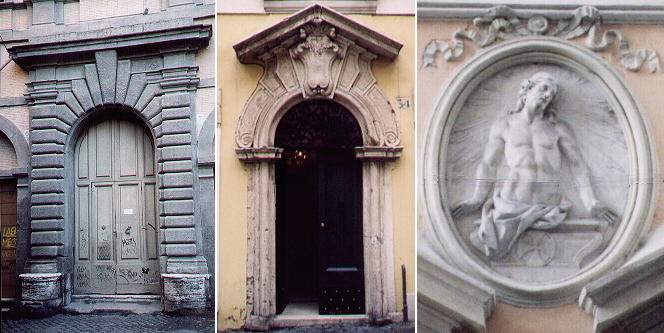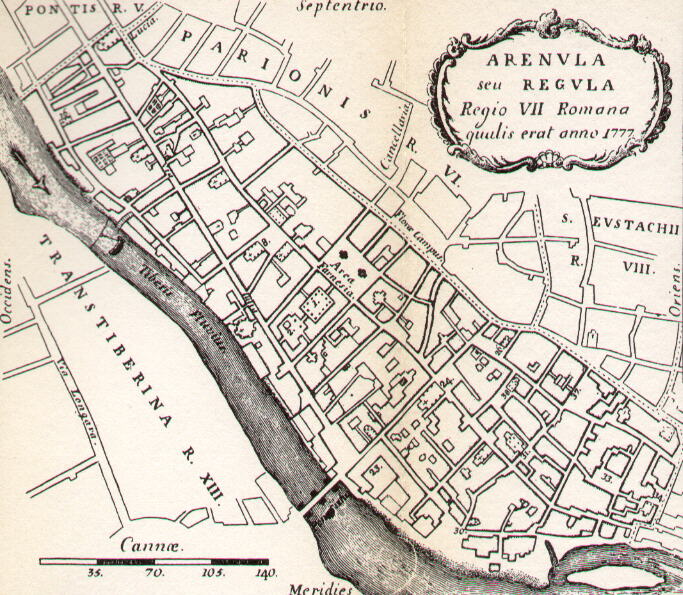  Rione VII Regola
Rione Regola was named after "regola" a word derived from "arenula" (sand) with reference to a beach located near
Ponte Sisto. It borders to the west on Ponte,
to the north on Parione and Sant'Eustachio, to the east on Sant'Angelo and to the south
on the Tiber.
The symbol of Rione Regola is a rampant golden hind. According to a legend, after a flood, a golden head of a hind was found on the beach of Regola. Rione Regola is mainly a Renaissance quarter with very few signs of Ancient Rome. However the long street which crosses the whole rione from NW to SE follows an ancient Roman street and the straight street leading to Ponte Sisto does the same. It became a very densely populated area during the Middle Ages due to its proximity to the river which at the time was the only source of water. Most of the streets are still named after the artisans who had their workshops there. Regola was a sort of industrial district of Rome: Via dei Cappellari (hatters), Chiodaroli (nail-makers), Pettinari (comb-makers), Baullari (case-makers), Giubbonari (dress-makers), Vaccinari (fur-makers), Calderari (coppersmiths), indicate just some of the activities which were performed in Regola. The rebuilding by Sistus IV in 1475 of Pons Aurelius, called after him Ponte Sisto and a few years later the opening by Julius II, nephew of Sixtus IV, of a straight street linking Ponte Sisto with Ponte S. Angelo, changed in part the nature of Regola. Via Giulia, named after the pope, became the most important street of Renaissance Rome and Paulus III Farnese built across the street his palace and his garden. Regola did not have large churches, the majority of them being churches belonging to a guild.
relief by Pietro Bracci near Palazzo Farnese In addition to the monuments shown in the pages listed below, Regola has many other memories of the Renaissance and of the Baroque and Late Baroque periods as the images above show.
Legend of the numbers in the map: 1) Main courtyard of Palazzo Farnese 2) Second courtyard of Palazzo Farnese 8) S. Caterina della Ruota 16) S. Niccolò degli Incoronati 23) Collegio Ecclesiastico a Ponte Sisto 24) S. Trinità dei Pellegrini 26) S. Martino ai Pelamantelli 30) Santi Vincenzo ed Anastasio alla Regola 31) S. Maria in Monticelli 33) Palazzetto Cenci 34) Palazzo Cenci 37) Palazzo Santacroce 38) S. Salvatore in Campo 
Main monuments of Rione Regola The red X mark the main changes which occurred after 1777: a) line linking several X along the river: in the 1880s huge walls were erected along the Tiber: this effort included a redesign of the river front which required the pulling down of some minor churches and the shortening of Collegio Ecclesiastico a Ponte Sisto; b) line linking two X: the opening of a large road (Via Arenula) cut Regola into two parts, thus isolating of the part of Regola next to Rione Sant'Angelo; c) top of the map: a partially aborted attempt to open a modern road across Via Giulia interrupted the series of Renaissance buildings along the street; d) X next to the church painted in red: most of Ospizio dei Pellegrini was pulled down and replaced by modern buildings. The different colours group the monuments which are shown in the same page. You can also have a look at it from the Janiculum: S. Eligio degli Orefici, Palazzo Farnese and Ponte Sisto.
 or to
The Coats of Arms of the Popes or
to My Home Page on Baroque Rome or to
My Home Page on Rome in the footsteps of an XVIIIth century traveller or to
The Coats of Arms of the Popes or
to My Home Page on Baroque Rome or to
My Home Page on Rome in the footsteps of an XVIIIth century traveller
|
All images © 1999 - 2004 by Roberto Piperno. Write to romapip@quipo.it


